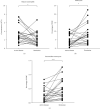Disease Activity and Tendency to Relapse in ANCA-Associated Vasculitis Are Reflected in Neutrophil and Intermediate Monocyte Frequencies
- PMID: 38213873
- PMCID: PMC10781522
- DOI: 10.1155/2024/6648265
Disease Activity and Tendency to Relapse in ANCA-Associated Vasculitis Are Reflected in Neutrophil and Intermediate Monocyte Frequencies
Abstract
Antineutrophil cytoplasmic antibody (ANCA)-associated vasculitis (AAV) is a group of autoimmune diseases with inflammation affecting small blood vessels and includes granulomatosis with polyangiitis (GPA) and microscopic polyangiitis (MPA). In this study, we investigated granulocyte and monocyte subsets in a large cohort of AAV patients with emphasis on disease activity and tendency to relapse. A cohort of 105 patients with GPA or MPA and 126 healthy controls (HCs) were included. Clinical and laboratory data were collected for all patients, including disease activity, tendency to relapse, and pharmacological treatment. Using flow cytometry, circulating eosinophils, basophils, neutrophils, and monocytes were assessed. The monocytes were subdivided into classical (CD14++CD16-), intermediate (CD14++CD16+), and nonclassical (CD14-CD16+) monocytes. Mature (CD16high) or newly released (CD16dim) neutrophils were defined, as well as the frequency of CD177+ neutrophils. AAV patients displayed increased frequencies of intermediate monocytes, mature and newly released neutrophils, and an expanded population of CD177+ neutrophils compared to HC. MPA patients differed from GPA patients in terms of lower frequency of classical monocytes. No differences in cell frequencies regarding ANCA phenotype were observed. Paired data from 23 patients demonstrated that active disease was associated with an increased frequency of mature neutrophils and a decreased frequency of monocytes, in particular intermediate monocytes. Moreover, GPA patients with a tendency to relapse displayed an increased frequency of mature neutrophils with increased expression of CD177+. Relapsing MPA patients, on the other hand, showed decreased frequency of intermediate monocytes. Finally, rituximab treatment was associated with increased frequencies of classical and intermediate monocytes. In conclusion, AAV patients exhibit a skewing of different neutrophil and monocyte subpopulations that are associated with disease subtypes, disease activity, rituximab treatment, and propensity to relapse. These changes may contribute to the inflammatory process and could potentially be used as biomarkers for relapse prediction.
Copyright © 2024 Sofia Smargianaki et al.
Conflict of interest statement
The authors declare that they have no conflicts of interest.
Figures





Similar articles
-
Longitudinal immune cell monitoring identified CD14++ CD16+ intermediate monocyte as a marker of relapse in patients with ANCA-associated vasculitis.Arthritis Res Ther. 2020 Jun 16;22(1):145. doi: 10.1186/s13075-020-02234-8. Arthritis Res Ther. 2020. PMID: 32546274 Free PMC article.
-
Delta Neutrophil Index Is Associated with Vasculitis Activity and Risk of Relapse in ANCA-Associated Vasculitis.Yonsei Med J. 2018 May;59(3):397-405. doi: 10.3349/ymj.2018.59.3.397. Yonsei Med J. 2018. PMID: 29611402 Free PMC article.
-
CD14 expression is increased on monocytes in patients with anti-neutrophil cytoplasm antibody (ANCA)-associated vasculitis and correlates with the expression of ANCA autoantigens.Clin Exp Immunol. 2015 Jul;181(1):65-75. doi: 10.1111/cei.12625. Clin Exp Immunol. 2015. PMID: 25766482 Free PMC article.
-
ANCA associated vasculitis (AAV): a review for internists.Postgrad Med. 2023 Jan;135(sup1):3-13. doi: 10.1080/00325481.2022.2102368. Epub 2022 Jul 21. Postgrad Med. 2023. PMID: 35831990 Review.
-
Monitoring disease activity in antineutrophil antibody-associated vasculitis.Scand J Immunol. 2023 Jul;98(1):e13284. doi: 10.1111/sji.13284. Epub 2023 May 11. Scand J Immunol. 2023. PMID: 37132459 Review.
Cited by
-
Targeting mitochondrial complex I of CD177+ neutrophils alleviates lung ischemia-reperfusion injury.Cell Rep Med. 2025 May 20;6(5):102140. doi: 10.1016/j.xcrm.2025.102140. Cell Rep Med. 2025. PMID: 40398393 Free PMC article.
-
Neutrophils and Platelets as Key Players in the Pathogenesis of ANCA-Associated Vasculitis and Potential Sources of Disease Activity Biomarkers.Diagnostics (Basel). 2025 Jul 29;15(15):1905. doi: 10.3390/diagnostics15151905. Diagnostics (Basel). 2025. PMID: 40804869 Free PMC article. Review.
References
-
- Redondo-Rodriguez R., Mena-Vázquez N., Cabezas-Lucena A. M., Manrique-Arija S., Mucientes A., Fernández-Nebro A. Systematic review and metaanalysis of worldwide incidence and prevalence of antineutrophil cytoplasmic antibody (ANCA) associated vasculitis. Journal of Clinical Medicine . 2022;11(9) doi: 10.3390/jcm11092573.2573 - DOI - PMC - PubMed
MeSH terms
Substances
LinkOut - more resources
Full Text Sources
Medical
Research Materials

